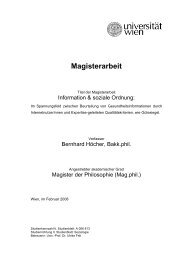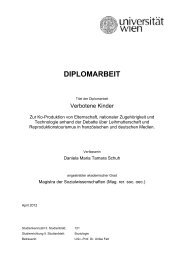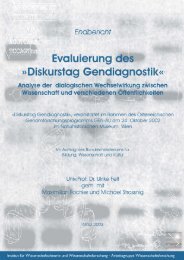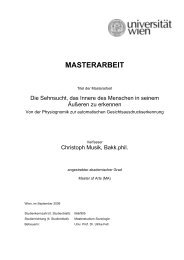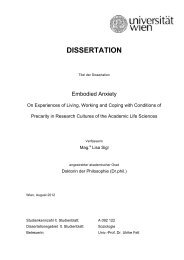MASTERARBEIT - Institut für Wissenschaftsforschung - Universität ...
MASTERARBEIT - Institut für Wissenschaftsforschung - Universität ...
MASTERARBEIT - Institut für Wissenschaftsforschung - Universität ...
Create successful ePaper yourself
Turn your PDF publications into a flip-book with our unique Google optimized e-Paper software.
4.5 goals and scope of the project 39<br />
they can bring along has been widely ignored so far although it might<br />
be a key aspect to understand people’s engagement and support for<br />
the new technology. Nevertheless, and I am going to show this in<br />
the writing, the imagination of futures was opened up by Count Zeppelin.<br />
His different conceptualizations of his technology and its uses<br />
enabled not just a limited, but very diverse public to get attached to<br />
the airship. He himself opened the discourse around the purpose<br />
of his invention thus allowing for more different groups to imagine<br />
different futures with his machines. This fits nicely to another theoretical<br />
conception mentioned: the consideration of how those imaginaries<br />
are assembled by Felt tie into the development of those foundations<br />
of SCOT. They show that interpretations of technology are not<br />
just there or given, but develop and change over time. This process of<br />
development does, of course, underlie influences and can thus be controlled<br />
or it can at least be attempted to gain control over it. Therefore,<br />
Jasanoff’s concept is going to be one keystone to my work. However,<br />
I use her concept a bit different from her original intention: Jasanoff<br />
aims at illuminating how science and technology policies can lead<br />
to a redefinition of conceptualizations on nationhood and its documentation.<br />
The case of Zeppelin airships can show how different<br />
imaginations of a technology can be united in common points and<br />
how this unity can be used to build a shared concept of a nation<br />
in the first place. Thereby, S&T policies are made themselves. This<br />
conceptualization of a case has three, maybe four goals:<br />
1. First of all to enrich the number of cases with one of a different<br />
kind: Many STS cases present deal with recent technological developments.<br />
The study at hand would provide another historic<br />
example to show that it is suitable for the same analysis.<br />
2. Secondly, it aims at enriching the research around zeppelins by<br />
a new perspective. While much has been written about it, it<br />
is still hardly reflected what fascinated people about it - the<br />
proposed application of imagined futures will contribute to understanding<br />
the social dynamics in a better way and enrich the<br />
existing literature by a further perspective.<br />
3. Thirdly, it adds to the relatively new concept of STI: while developed<br />
as a top-down perspective, the case at hand shows that<br />
these imaginaries can also work bottom-up and be a useful resource<br />
to bring order into unordered discourse. Top down is<br />
meant here as an interpretation that Jasanoff does not mean primarily<br />
that STIs are developed through discourse in the entire<br />
socitey. Instead, the STIs are meant to be developed for socitey<br />
and then spread in it. Much like the re-interpretation of ’Frenchness’<br />
in the French nuclear enerrgy discourse[20], the discourse<br />
happens in rather small groups for society, not by society. The formation<br />
of groups (or even nations, see above) through shared



